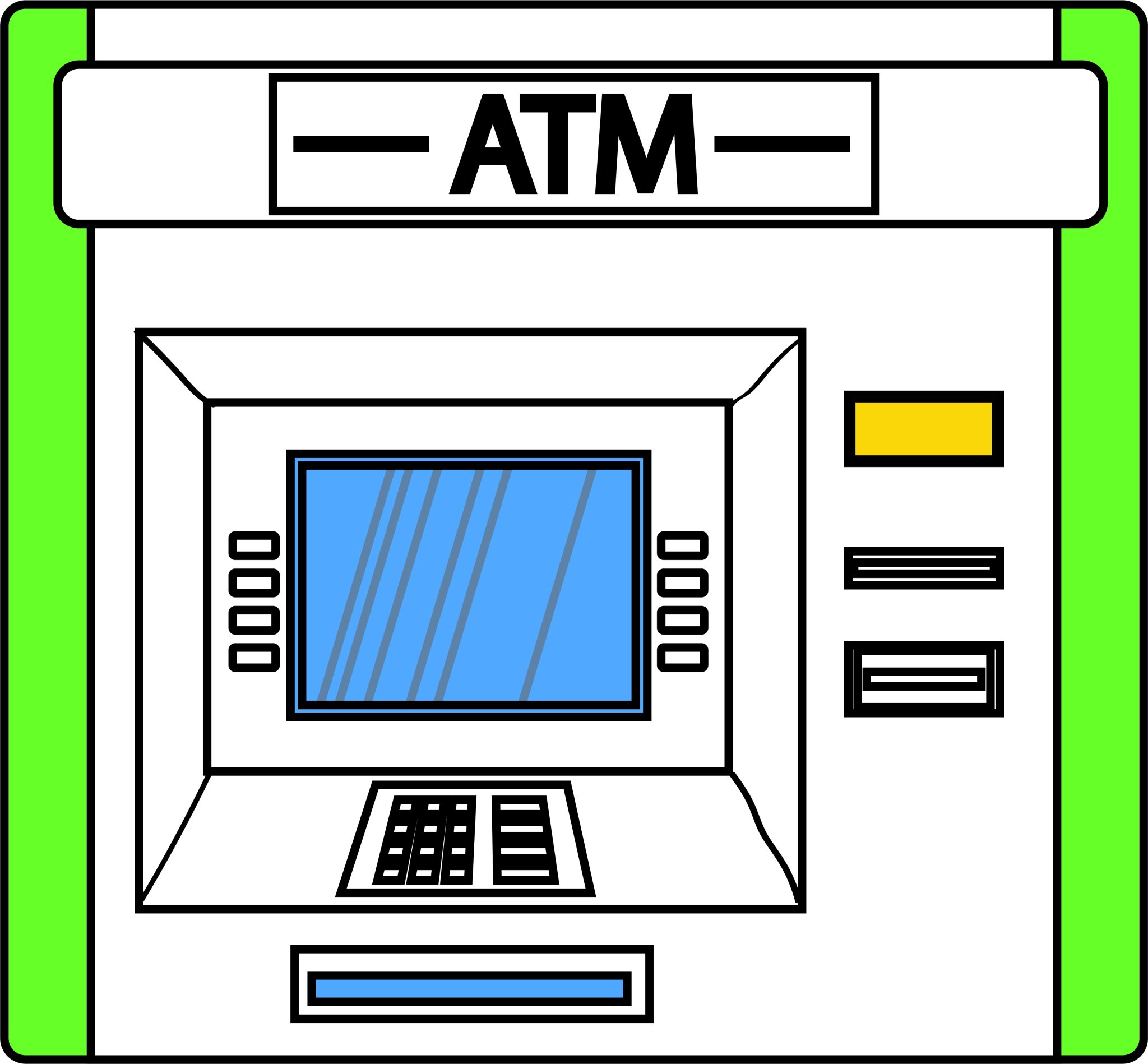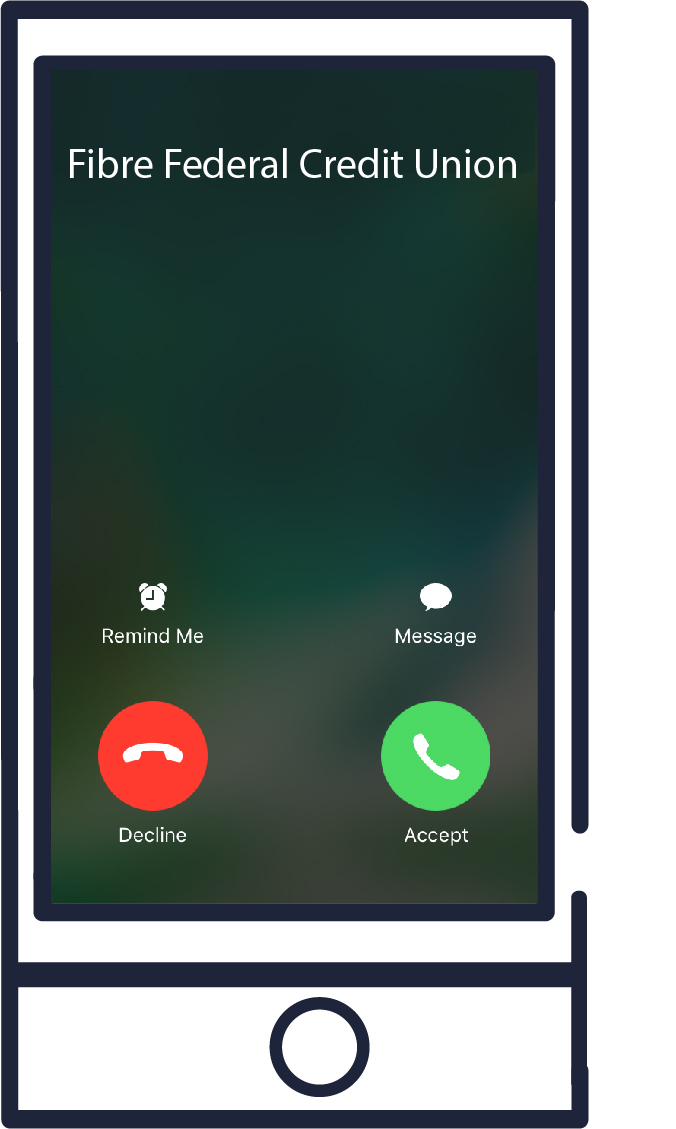We're invested in your safety!
Nobody hates fraud more than we do, and we’ll continue to make fighting fraud a top priority. Says Shelly Buller, Fibre Federal’s EVP Chief Operations Officer: “We continue to look for ways to manage the risk and member service related to fraud and that is especially true for card fraud. We are not resting on those tools alone as we continue to monitor and look for ways to reduce the risk.”
We’ve taken the following steps to safeguard our members’ accounts:
- Implemented chip technology in our credit and debit cards
- Added chip card readers to our ITMs
- Created card transaction rules which look for transactions outside of the member’s normal spending pattern. If transactions outside of the normal card usage appear, the transaction is flagged for closer monitoring and/or blocking of the transaction and card, as warranted. Members are contacted when those steps are taken.
Fraudsters are out there, and they’re working overtime.
Be smarter than the scammers and think twice before clicking any links or sharing any sensitive information, no matter how urgent the communication makes it seem. If you receive a call from someone claiming to be us, but they request or demand your personal information, hang up and contact us directly. And if you receive a text or email urging you to click links or respond immediately, remember that urgency and pressure is a common fraudster tactic. When in doubt, you can always contact us with any questions about your account.
If you recognize a fraudulent text or email claiming to be us, we encourage you to take a screenshot and email it to fraud@fibrecu.com before deleting the message.
If you ever share personal information with a scammer, it’s imperative you contact us immediately so we can help secure your accounts.
-

Here’s how you can keep your accounts safe from skimming devices at merchant point of sale terminals and/or non-Fibre ATMs:
- Be aware of the signs of an ATM skimming device. Watch this video for pointers.
- Use Online Banking to monitor your accounts regularly, and take advantage of its transaction alerts options. If you’ve not yet signed up for Online Banking, you can sign up here. Notification examples include balance alerts, insufficient funds alerts, and transaction alerts.
- Use Fibre Card Manager to define when, where, and how your cards can be used, and send alerts on your mobile device.
- Contact us if you detect fraudulent activity. Our Card Services Department will work closely with you to resolve the problem.
- If you detect fraud after hours, call 1-833-462-0796 to discuss temporary blocks on your card due to suspicious activity.
Read More: How to Prevent Fraud With a Card Control App
-

Be aware that Caller IDs can be spoofed. If you get a call with a “Fibre Federal Credit Union” caller ID and you sense something amiss, ask for the person’s name, and tell them you will call them back at the number you have for Fibre Federal (360-423-8750). Please let us know immediately if you feel you have received a fraudulent call from someone posing as a Fibre Federal employee. In addition, our legitimate fraud monitoring service will ask to send you a confirmation code to validate your identity and prove they are who they say they are.
-
Identity theft is defined as the illegal use of someone else’s personal identifying information (such as Social Security Number, debit, or credit card) in order to get money or credit. It’s estimated that identity theft occurs every two seconds in the United States, and it has been the number one complaint to the Federal Trade Commission every year since 2000.
Your liability in the event of identity theft (as well as credit card theft) is limited by both state and federal regulations that protect consumers and by industry rules. Credit card users in particular are protected by the Truth in Lending Act and the Federal Reserve Board’s Regulation Z, which limit their liability for unauthorized transactions to $50. In addition, the Electronic Fund Transfer Act and the Board’s Regulation E specify liability limits for unauthorized electronic transactions and set forth procedures for recouping funds stolen from consumers’ bank accounts. The limits are $50 if you notify us within 2 days of learning of the loss or theft of a debit card and up to $500 if you notify us after 2 days but within 60 days. You have 60 days to report any discrepancies after receiving your monthly statement to help recover any fraudulent losses, otherwise you could be held responsible for the full amount of such transactions.
Some tips for avoiding identity theft:
- Deter identity thieves by safeguarding your information, including your Social Security Number and account numbers.
- Thieves can place “skimming” devices on ATMs and Point of Sale locations to steal card and PIN numbers, so they can make fake cards. Look for anything unusual near the speakers and beside the screen. Gas pumps are key places to watch for these devices. Pull or twist on the device where you insert your card to make sure it’s secure. If it is loose, there may be a skimming device inside. If you find a skimming device, call police immediately.
- Password protect your smartphone, and install anti-virus software on your phone, such as Avast. Phones have been the latest targeting in SMS messaging, and apps that mimic banking apps, or run while using banking apps.
- Keep up-to-date anti-virus software on your laptop and PC.
- Be sure to monitor your account on a regular basis. Utilizing Online Banking and Mobile Banking to quickly assess your account will help in catching any fraudulent activity sooner, and limiting your liability.
- Do not write your PIN on anything you keep in your wallet or purse. The best method is to make the PIN something only you know and can memorize. Refrain from using your birth date, child’s birthday date, part of your Social Security Number, etc. If your wallet or purse is stolen with the card inside, even though the PIN is not written down, the thief has access to potential PIN combinations.
- Make sure your phone number is up-to-date. If we need to reach you regarding potential fraud, it will be important to have a current phone number attached to your account.
- Use your PIN for debit purchases whenever possible. Your PIN is another level of protection that is specific to your card only. This is especially helpful when traveling.
- One of the things we do to prevent fraud is to keep our eyes open for any unusual use of your cards. For example, if you normally only use it locally and suddenly, charges occur at a European resort, that could indicate suspicious activity. For your protection in that case, we might block further transactions from your card and try to contact you. You can avoid that inconvenience by contacting us before you travel. You can also use Fibre Card Manager to set travel restrictions and notifications.
- In case you do have to report fraud or suspicious activity, make a list of cards and account numbers, but keep it in a secure place instead of in your wallet. This list will help to put an end to fraud as quickly as possible.
- If you or someone you know is a victim of elder fraud, call the National Elder Fraud Hotline at 833-FRAUD-11 (833-372-8311).
- If your card is lost or stolen, we are here to help. If you report suspicious activity to us we will stop further use of the impacted card, replace it and issue a new card number at no cost to you. Contact our 24/7 Card Care Center at 1-833-462-0796.
- EMV chip cards provide an extra layer of security when you use them on site (not online). Not all merchants have caught up with this technology trend. If the merchant’s chip system isn’t operating yet, you can still use your card, but continue to monitor your transactions regularly.
- Be sure your card is returned following each purchase and that it is indeed your card.
- Wait for the receipt. Never leave it at the checkout counter. Keep receipts with you, not in your shopping bags, and dispose of them safely.
- Be sure that we have your updated email address. We will send you an alert when there is possible fraud on your account. For example, when your Online Banking challenge questions change, when your email address changes, or when a transfer to another member is requested.
- You can also set up your own alerts via Online Banking or Mobile Banking. These alerts can be sent to you either by email or text message. You can set these alerts to notify you when your balance falls below a certain amount, for certain types of transactions, and more. When logged on, select Accounts, then Account Alerts.
For more tips, please see the Federal Trade Commission’s information about Identity Theft: What To Know – What To Do
-
Cyber criminals never seem to sleep, so it’s important to educate yourself about the common tactics these fraudsters use may use. You can access a directory on common cyber crimes here.
-

By understanding some of the scams that are out there, you are better able to protect yourself. Here is the CO-OP Solutions list of most prevalent financial scams:
1. Gift cards, secret shoppers, and the allure of fake offers
This scam works as follows: consumers are drawn in by a phony e-mail or social media post to become a “secret shopper” in exchange for some form of financial gain. When a consumer agrees to participate, the fraudster seals the deal by delivering a very large counterfeit check. The criminal then asks the consumer to deposit the check and purchase gift cards with the funds – keeping a small portion of the proceeds as compensation for being the “secret shopper.”
The victim here (a loose term, considering that most people will realize this is a scam) is asked to e-mail photographs of the gift cards, front and back, so the criminal can use them immediately – before the counterfeit check has a chance to bounce.
Takeaway: The bounced check and all associated damages are the responsibility of the consumer because the criminal and his or her e-mail address are long gone by the time the check bounces.
“What this means is that the amount of the bounced check will be deducted from the consumer’s account when the check is returned,” explained Katie Clark of Northwest Credit Union Association (NWCUA). “If they don’t have funds in the account to cover the returned check, then the consumer’s account will be overdrawn.”
2. “You can never be too rich or too thin” – and other e-mail scams
Some consumers are attracted to “get rich” and “get thin” offers, and unfortunately an age-old diet scam has surfaced again, targeting consumers with spam e-mails. When an unwitting consumer signs up for the “self-improvement” deal, that individual agrees to recurring billing for the proposed service.
Takeaway: This ongoing billing arrangement is difficult to stop. And, in some cases, the stolen payment card information is used for other fraudulent purposes.
“Consumers should carefully read any agreement before providing billing information as these transactions are not disputable since the member authorized the company to deduct the recurring bills from their checking account or debit card,” Clark said.
3. Account takeover schemes
This scheme is dangerous for both credit unions and service providers and to their members. Social engineers, often armed with data from recent breaches, call into financial institutions on a regular basis, posing as customers or members looking to take over their accounts. And, it can be difficult for credit union employees to tell the difference because these criminals dial in with answers to the member’s authentication questions (which they have sourced from the dark web).
4. Counterfeit money orders
Fake money orders are frequently used for online purchases from websites like Craigslist. The problem is that high-quality counterfeit money orders are hard to distinguish from the real thing.
Takeaway: Members holding a potentially counterfeit money order should call the U.S. Postal Service verification line at 1-866-459-7822. The U.S. Postal Service can verify the authenticity of money orders 48 hours after they are issued – and they can also offer tips on how to recognize fake money orders in the future.
“If other checks are received as payment for a Craigslist sale, the credit union can potentially help the member determine the legitimacy of the check (often a cashier’s or official check) by contacting the financial institution that issued the check,” Clark advised.
5. “MSN” help desk fraud
This form of fraud is usually directed at the elderly. A criminal calls an unsuspecting consumer and warns that his or her PC – however seldom used – is riddled with viruses. The fake technician offers to assist, and then dispatches the victim to a local big box store to buy prepaid gift cards which are given as payment for the tech support services.
Takeaway: Losses to elderly victims of this scam can soar well into the thousands – and the criminals are willing to take every nickel without remorse. Some big box stores have started to try and identify consumers who may be embroiled in these scams, but they can run into roadblocks when victims are either mentally incapacitated – or reluctant to admit they have fallen for a scam.
6. Card cracking
This rip-off scheme typically victimizes our youth. A fraudster reaches out to a young person via social media and convinces the potential victim that they can both benefit by helping each other out – with the young account holder receiving a small sum – $100 or so – as compensation for cooperating with the fraudster.
The victim then gives the criminal access to his or her online banking credentials, so the criminal can deposit counterfeit checks into the account. The fraudster also typically requires the usage of the account holder’s debit card and, in some cases, accompanies the co-conspirator to an ATM to perform withdrawals against the counterfeit checks that have been deposited. This is especially troubling if the account holder is a minor in the company of an adult criminal.
Bottom Line: All financial damages, including non-sufficient-funds checks, fall back onto the young consumer. And that easy $100 profit? It was fake as well.
7. Direct mail scams
Bogus – but official-looking – letters are delivered every day to random consumers with stern requests for social security numbers and other personally identifiable information. Some of these letters are printed on what looks like big bank letterhead and, in all cases, there is at least one “official looking” hard-copy form that the consumer is asked to fill out and return.
Takeaway: The addresses on these letters and the return envelopes provided are criminal addresses. They are not P.O. boxes belonging to actual businesses. The main objective here is identity theft. This scam can be very convincing to consumers because the U.S. Postal Service has not been a criminal mainstay since the proliferation of email in the mid-1990s.
Bottom Line: An informed consumer is an empowered one. Be sure to recognize the signs of fraud will both reduce your risk and inspire your trust.
Resource: CO-OP Solutions. “Be on the Lookout for These Seven Scams.” NWCUA, 2018, nwcua.org/2018/09/18/be-on-the-lookout-for-these-seven-scams/.
Get more simple refreshers on how to recognize scams here.
Test Modal
Modal Content
Ea rerum vel molestiae omnis molestias. Et ut officiis aliquam earum et cum deleniti. Rerum temporibus ex cumque doloribus voluptatem alias.
Auto Link
Leaving Our Website
You are leaving Fibre Federal Credit Union and TLC’s website. This link does not constitute an endorsement by Fibre Federal Credit Union and TLC of any information, products or services on this external website. We make every effort, however, to ensure all linked sites follow similar privacy policies as ours to offer maximum security and privacy.

